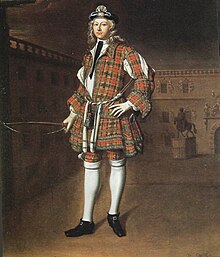Origins

In the late 18th and early 19th centuries, vast amounts of Scottish immigrants settled in the Carolinas. [8] [6] Many societies are dedicated to Scottish heritage or the conservation of Scottish culture in the Carolinas (such as the St. Andrew's Society of Carolina). [9] Peter MacDonald, a Scottish historian and tartan-maker, partnered with the St Andrew's Societies of North Carolina and Charleston to create the Carolina tartan. The inspiration for the Carolina tartan was a parcel of cloth from the uniform of the Royal Company of Archers (c. 1730) believed to be worn in some capacity by King Charles I during his nuptial vows. [10] The Royal Company of Archers was founded in 1676 in Edinburgh to promote archery and the uniform that the Carolina tartan was based on was the first uniform of the company. The uniform was made of tartan, which was often worn by Jacobites, who made up a substantial portion of the company, to profess anti-unionism. [11] This particular uniform was worn until tartan was banned in Britain by the Dress Act 1746, tartan was worn again when the act was repealed but instead of the original red sett, it was replaced by the Black Watch pattern.